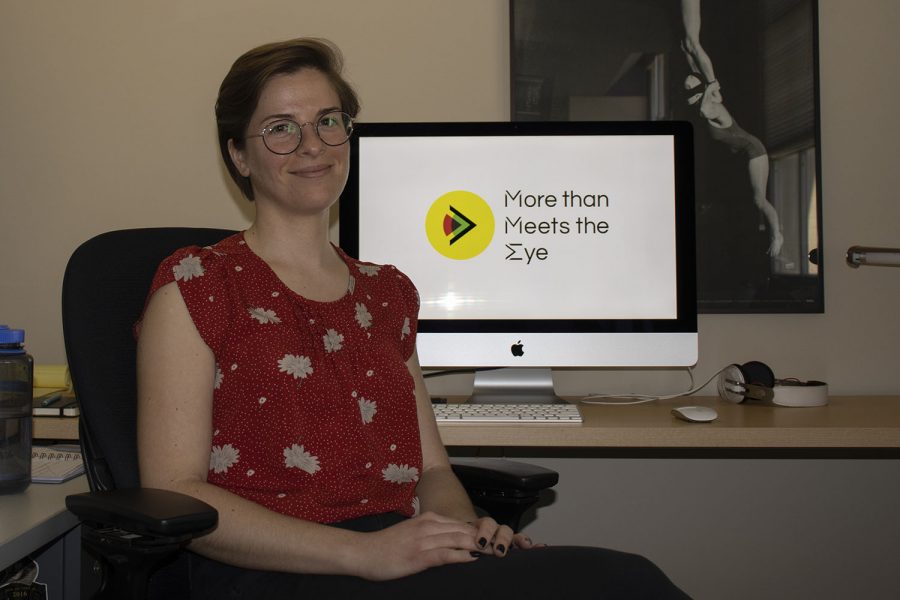A nontraditional ‘leap’ from publishing into graphic design
Alyssa Varner graduated from the University of Iowa with a passion for books and writing. She pursued a career in publishing, only to find her true calling in graphic design — taking a nontraditional path into the industry. Since then, she’s intertwined her two passions into a graphic novel series.
Graphic designer Alyssa Varner poses for a portrait on Friday, March 6, 2020. Varner works in the Digital Scholarship & Publishing Studio as a creative coordinator and graphic designer.
March 30, 2020
With eyes on her computer screen and hands on her keyboard, Alyssa Varner scrolled through a somewhat endless stream of files on design projects and illustrations. Considering the creativity behind each individual design, it’s no surprise that the University of Iowa Digital Scholarship & Publishing Studio creative coordinator became a graphic designer after earning a degree in English and creative writing.
Publishing editorial assistant Varner graduated from the UI in 2008, and said she then envisioned herself working among authors and their books. After a decade living in New York pursuing a career in publishing, Varner said she found the path focused heavily on typography, the “visual look of reading,” and Adobe Creative Suite — contrary to her preconceived notion that she would work solely with words.
Overtime, Varner said she unintentionally fell in love with the visual elements of publishing and began teaching herself graphic design through YouTube tutorials. She eventually began night classes at The Graduate Center City University of New York in Manhattan, Varner said.
“My brain was like, ‘Oh my God, this makes sense for some weird reason,’ ” Varner said. “I found that I was really able to apply some of the skills I had that I learned as an English major, especially with self-editing, to things like logo design and layout design — where you don’t want things to be too crowded. You want the eye to feel relaxed and calm, and you want to draw attention to the important things. So, I just see a lot of parallels between writing and design, so it isn’t as huge of a weird leap as it might sound on paper.”
RELATED: The art and heart behind graphic design
Varner said the deeper she got into graphic design, the more interested she became in drawing and digital illustration. Consequently, Varner said she discovered a passion for logo design and the complex symbolism that logo marks often have.
Following a move back to Iowa, Varner applied for an open position at UI Libraries. UI Digital Scholarship & Publishing Studio Senior Developer Matthew Butler said Varner was one of many strong applicants — 60 percent of which were female.
According to a 2016 American Institute of Graphic Arts design census, gender representation within the graphic-design industry is 54.5 percent female, 43.9 percent male, 0.6 percent nonbinary/third gender, and 0.1 percent preferred not to answer or to self-describe.
Despite the higher percentage of females in the industry, 2016 data from the census shows that, on average, a woman earns 81 cents for every dollar earned by a man in graphic design jobs.
Varner acknowledged that the gender pay gap does exist in the industry but doesn’t let it discourage her from her passion for graphic design.
It’s become an important piece in her life, and often her professional passion overlaps into her personal life, said UI psychologist Assistant Professor Isaac Petersen, Varner’s fiancé.
Petersen said Varner writes and illustrates graphic novels to bridge the gap between her dual passion for writing and design. She’s penned four of a five-part series, Blown Away, sci-fi books set in the 1980s Midwest. The four volumes are available either online or at Prairie Lights, he said, with a fifth in the works.
“I think the comic books and the graphic novels that she writes — [they] help fulfill a passion of hers,” Petersen said. “She just really enjoys writing, and she enjoys the process of creating something that people can enjoy. The comic book series, Blown Away, that she wrote tells a story that was captivating to her, based on prior experiences that she had.”
Butler added that Varner brings creativity and an artistic eye to projects that are often dry and technical. Her role as creative coordinator is beneficial, he said, because she has the skills to implement artistic aspects that may otherwise be overlooked in projects.
Varner’s nontraditional path into the graphic-design industry benefits her work at the UI Digital Scholarship & Publishing Studio, Butler said, because it makes her a good communicator and collaborator with different departments — giving her a competitive edge in the application process for her current position.
“I’m a big supporter of [that] circuitous, nontraditional route. I took it myself. I went to art school only to become an application developer later. So, I think there’s a lot to be said for being self-taught [depending] on where you’re at in your career,” Butler said. “If [Varner] had got a bachelor’s degree in graphic design, I think she would have had a different route through it. But I mean, once you kind of get through that route, it doesn’t really matter what your educational background is. The work speaks for itself.”














